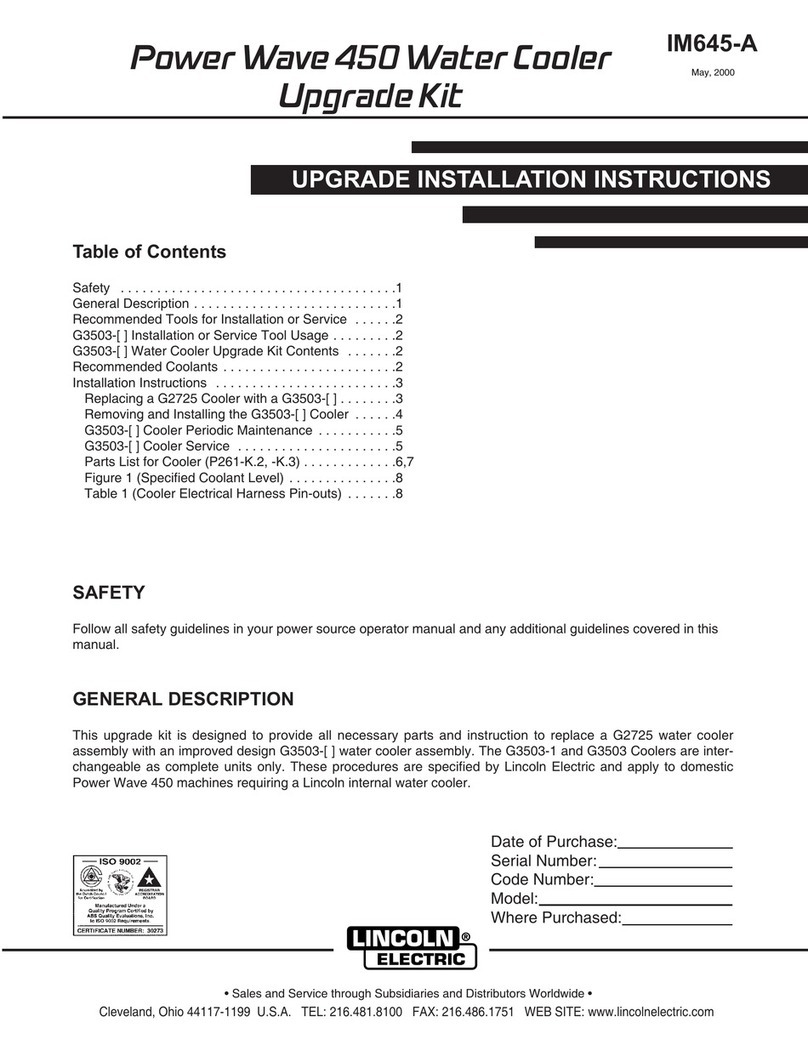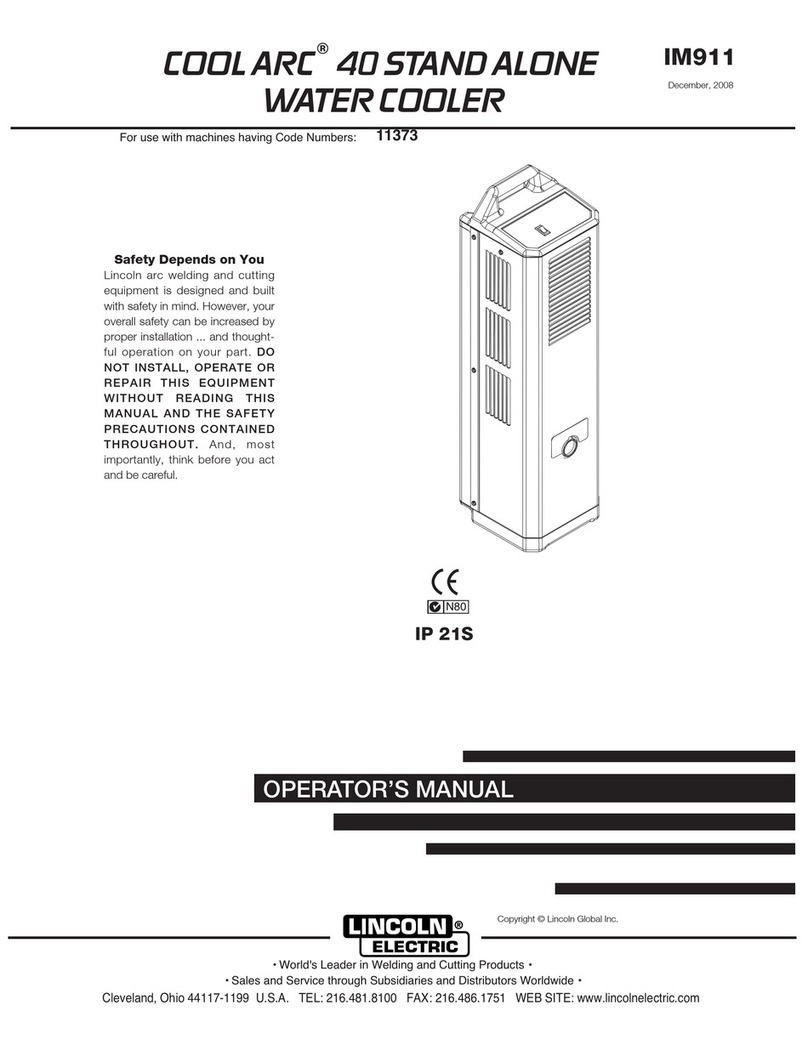
-5
•Never operate the cooler with the reservoir fill cap
removed.
•Avoid placing the cooler near areas of extreme heat.
•Avoid placing the cooler near a flux hopper or an
area where dust build-up is extreme.
•Avoid kinking or putting sharp bends in any water
lines.
•Keep all water lines clean.
Turning The System ON
After filling the reservoir and connecting the coolant
hoses to the COOLARC-25 cooler per the Installation
Sections, plug the unit into an electrical receptacle for
start-up operation. Be certain that the power input into
the unit matches the cooler’s rated input. COOLARC-25
cooler cordsets contains a 90 angled CEE 7/4, 7/7
Schuko compatible plug. The plug mates with an
auxiliary receptacle located at the back of many
international Lincoln power sources for power supply to
a COOLARC-25 cooler.
You will be able to hear the fan running and feel air flow
out of the back of the unit when the cooler is operating.
When first starting the unit, check all of the water lines to
insure that no water leaks are present. Water leakage
causes poor welding performance, poor cooling
performance, low welding component and pump life and
potential electrical safety hazards.
Cooling Efficiency
1. COOLANT RETURN
2. COOLANT IN TAKE
3. PUMP
4. FAN
5. HEAT EXCHANGER
6. HEATED AIR OUT
7. COOLANT OUT
8. COOLANT IN
9. RESERVOIR
FIGURE 7
Circulation of COOLARC-25.
The high cooling efficiency COOLARC-25 offers a
cooler, more comfortable weld than conventional air-
cooled procedures as well as leading competitors water
cooled systems. The corrugated radiator of the heat
exchanger improves heat convection with minimal air
flow restriction. This design ensures a durable
construction which is able to withstand impact of
different objects through air slots. Figure 7 shows work
principles of the COOLARC-25.
The COOLARC-25 cooler effectively removes the heat
of the arc away from the gun or torch handle and places
it into the exiting air flow at the back of the cooler.
Ambient air temperature can affect the cooling
parameters of the COOLARC-25.
For example:
•COOL day (50°F, 10°C): More HEAT is transferred
from the water in the heat exchanger to the air. The
water is COOLER and more HEAT is transferred
from the gun or torch to the water.
RESULT: THE GUN OR TORCH FEELS COOLER
•HOT day (100°F, 38°C): Less HEAT is transferred
from the water in the heat exchanger to the air. The
water is HOTTER and less HEAT is transferred from
the gun or torch to the water.
RESULT: THE GUN OR TORCH FEELS HOTTER.
Unlike other water coolers that depend on bulky
reservoir size, the high efficiency components of
COOLARC-25 cooler allows the reservoir size to be
small. The result is a lightweight, portable unit.
Cooling Efficiency - Recommended Values
COOLARC-25 ref: K14037
Max welding current TIG 100% duty cycle 350A
Max welding current MIG 100% duty cycle 350A
Maintenance
WARNING
For any maintenance or repair operations it is
recommended to contact the nearest Technical Service
Center or Lincoln Electric. Maintenance or repairs
performed by unauthorized service centers or personnel
will null and void the manufacturer's warranty.
Heat Exchanger Maintenance
To maintain maximum efficiency, the heat exchanger
should be kept clean from dust and dirt buildup. Clean
the heat exchanger periodically using a vacuum hose or
low pressure air line. Avoid placing the unit near a flux
hopper or a flux waste container. A clean heat
exchanger offers better cooling performance and longer
product life. If extremely dirty conditions exist, it may be
necessary to remove the heat exchanger completely
from the cooler for a thorough soap and water cleaning
of the cooling fins. Use care to avoid damaging the fins.
Reservoir Maintenance
The reservoir volume should be checked daily before
using the cooler. You can do it by observation the level
of the coolant in the sight window on the front panel..
The unit is full when the coolant level reaches upper
marker. Keep the reservoir full especially after changing
the water lines. The cooler should always be operated
with the reservoir fill cap on. In areas where dust can be
introduced into the reservoir through water lines or
reservoir fill cap removal, periodically flush the unit out.
Dump the old coolant and rinse the inside of the
reservoir. Add new coolant when finished. A reservoir
free from particle buildup and dirt offers better cooling
efficiency and longer pump, gun and torch life.
































